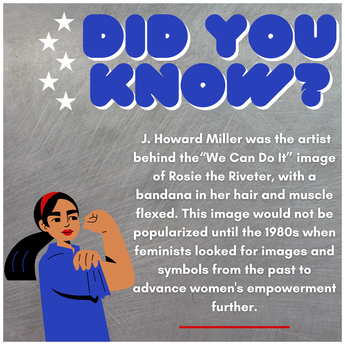-
About
Our Story
back- Our Mission
- Our Leadershio
- Accessibility
- Careers
- Diversity, Equity, Inclusion
- Learning Science
- Sustainability
Our Solutions
back
-
Community
Community
back- Newsroom
- Webinars on Demand
- Digital Community
- The Institute at Macmillan Learning
- English Community
- Psychology Community
- History Community
- Communication Community
- College Success Community
- Economics Community
- Institutional Solutions Community
- Nutrition Community
- Lab Solutions Community
- STEM Community
- Newsroom
- Macmillan Community
- :
- Newsroom
- :
- Learning Stories Blog
- :
- The Rosie Side of Women’s History: Rosie the Rivet...
The Rosie Side of Women’s History: Rosie the Riveter: She’s more than meets the icon
- Subscribe to RSS Feed
- Bookmark
- Subscribe
- Printer Friendly Page
- Report Inappropriate Content
They are represented on posters, songs, and films, and run over five million deep as a symbol of strength and feminism. They are the real-life war effort leading ladies. When the United States called for all hands on deck during World War II, traditional gender roles experienced a societal shift as women heeded the call to join the workforce. This created generational shockwaves and unmasked the untapped potential of women in the United States' war efforts. In 2017, the US Senate passed a national day of observance on March 21st to commemorate all these red-blooded riveters. And their names? Well, you can just call them Rosie.
Rosie, the Poster

Today, we collectively recall the image titled “We Can Do It” by J. Howard Miller. Comparatively, at the time, this image was seen by very few, as it was used for a production campaign for the Westinghouse Electric Corporation. “We Can Do It” was not popularized until the 1980s, when feminists looked for images and symbols from the past to advance women's empowerment further. It was only then that the charming yet tough persona of the Rosie the Riveter image we know today took center stage.
Rosie, the Song
With war looming and encouragement needed more than ever, composers and lyricists Redd Evans and John Jacob Loeb released the 1942 patriotic tune “Rosie the Riveter”, which became a national hit and was popularized by the group The Four Vagabonds. This song was known to have inspired the Norman Rockwell magazine cover of Rosie.
Rosie, the Film
“Rosie” became such an icon that there was a 1944 film adaptation with the eponymous title, starring Jane Frazee as Rosalind “Rosie” Warren in the musical comedy. Many years later, a 1980 war documentary titled “The Life and Times of Rosie the Riveter” was produced that told the true stories of five real-life Rosies from across the United States.
Rosie, the Origin Story
There is a lot of speculation as to who the “real” Rosie the Riveter was. By doing a simple web search you will find several articles, videos, and obituaries claiming a different woman as the “real” Rosie. After researching records, articles, and videos of information, the conclusion came to this – they are ALL the real Rosies. Here are some of the women who inspired the spirit of Rosie the Riveter.
- Naomi Parker Fraley, a California waitress who had worked in a Navy machine shop during World War II is said to likely be known as the inspiration for the “We Can Do It” poster so famously known today.
- Rosina Bonavita, the daughter of Italian Immigrants who worked as a riveter in New York and “set a speed record in building a Grumman Avenger torpedo bomber.”
- Rose Will Monroe, a Michigan native who had a chance encounter with actor Walter Pidgeon while riveting at an airplane factory, and ended up starring in a film depicting Rosie the Riveter as being a real “Rosie” herself.
- Rosalind “Roz” P. Walter, famously known as the inspiration for the Rosie the Riveter song, was born into wealth but answered the call to help during the war effort instead of going to college immediately. She also became the main benefactor of PBS.
- Mary Doyle Keefe, the original model for the famous Norman Rockwell painting. At the time she was a young telephone operator and happened to be Rockwell’s neighbor.
Behind the Flex
“Rosie the Riveter” was not one sole woman, race, or age. These mothers, daughters, and sisters worked on tanks, planes, ships, and other important materials needed for the war. Serving both in and out of uniform, these women answered the call to action and proved that jobs previously reserved for men could indeed be done effectively and efficiently by women as well.
Today, we honor all the Rosies who served their nation and contributed to not just a national victory, but the charge of women’s rights movements in the decades that followed. The daughters and sons of these women are lovingly called rosebuds and rivets. As the rosebuds and rivets (or grand-rosebuds/rivets) of today, how will YOU embrace the spirit of Rosie the Riveter today, and beyond?
This blog post is part of a month-long celebration of Women’s History Month organized by WOMEN@ML (Women of Macmillan Empowering and Networking), Macmillan Learning’s employee resource group for all employees who identify as women. During the month of March, WOMEN@ML celebrated and recognized an important historical woman each day of the month, drawing attention to their accomplishments and contributions to the world we live in today.

